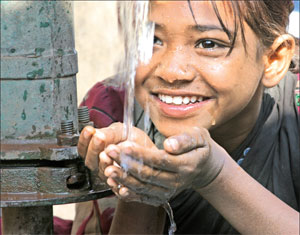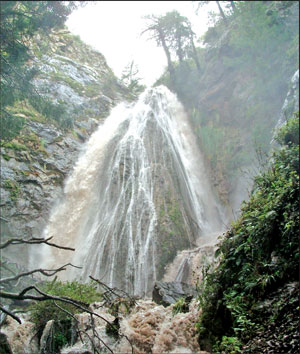|
World Water Day - March 22:
Freshwater - a dwindling resource
The world’s population has surpassed seven billion! What does this
mean in terms of meeting basic needs such as water and food? A growing
demand that cannot keep pace with available resources, especially when
it comes to water. Even though the supply of food can be increased the
water resources cannot be increased as it is not a growing natural
resource .It is in fact a fast dwindling resource that can pose a
serious threat to the survival of not only all living beings but also
the plant kingdom . Freshwater is a scarce resource; its annual
availability is limited and the demand is growing. Freshwater is an
important natural resource necessary for the survival of all ecosystems.
So, in general if there is no water there cannot be any life :water is a
critical issue for the survival of all living organisms.
 Some organisms can use salt water but many including the great
majority of higher plants and most mammals must have access to
freshwater to live. Some organisms can use salt water but many including the great
majority of higher plants and most mammals must have access to
freshwater to live.
Today there are more people relying on a finite amount of freshwater
for their survival than in the past . With World Water Day just round
the corner we like to focus on some vital information on this wonder
liquid many of us waste without understanding the consequences of our
careless actions.
The world is heading towards a water crisis. Scientists say that if
global warming continues to melt glaciers in the polar regions, as
expected, the supply of freshwater may actually decrease; First,
freshwater from the melting glaciers will mingle with salt water in the
oceans and become too salty to drink. Second, the increased ocean volume
will cause sea levels to rise,contaminating freshwater sources along
coastal regions with seawater.
Freshwater is a renewable and changeable, but limited natural
resource. Freshwater can only be renewed through the process of the
water cycle, where water from seas, lakes, rivers, and dams evaporates,
forms clouds, and returns to water sources as precipitation. However, if
more freshwater is consumed through human activities than is restored by
nature, the result is that the quantity of freshwater available in
lakes, rivers, dams and underground waters is reduced which can cause
serious damage to the surrounding environment.In order to better
understand water use and availability trends, scientists divide the
Earth’s surface into river basins. In each basin, the primary source of
water is precipitation. Rain and snow feed the river and its
tributaries, as well as groundwater, ponds, and lakes. Precipitation
also adds moisture to the soil, and crops take up the moisture through
their roots.
What is freshwater?
Freshwater is naturally occurring water on the Earth’s surface in ice
sheets, ice caps, glaciers, bogs, ponds, lakes, rivers and streams, and
underground as groundwater in aquifers and underground streams.
Freshwater is generally characterised by having low concentrations of
dissolved salts and other total dissolved
 solids. Freshwater is defined
as having a low salt concentration — usually less than 1 per cent
.Plants and animals in freshwater regions are adjusted to the low salt
content and would not be able to survive in areas of high salt
concentration (i.e. ocean).The term specifically excludes seawater and
brackish water although it does include mineral rich waters such as
chalybeate springs. The term “sweet water” has been used to describe
freshwater in contrast to salt water. solids. Freshwater is defined
as having a low salt concentration — usually less than 1 per cent
.Plants and animals in freshwater regions are adjusted to the low salt
content and would not be able to survive in areas of high salt
concentration (i.e. ocean).The term specifically excludes seawater and
brackish water although it does include mineral rich waters such as
chalybeate springs. The term “sweet water” has been used to describe
freshwater in contrast to salt water.
Sources of freshwater
The source of almost all freshwater is precipitation from the
atmosphere, in the form of mist, rain and snow. Precipitation also adds
moisture to the soil.
Most crops around the world are grown using only the soil moisture
provided by rainfall. When this moisture is insufficient, farmers apply
more water through irrigation. Some rain or irrigation water evaporates
without benefiting the plant, while some transpires through the plant’s
tissues during photosynthesis and returns to the atmosphere. Water
transformed into vapour in either of these ways is not available for use
again in that local area, so in practical terms, it is lost or
“consumed.”
Freshwater falling as mist, rain or snow contains materials dissolved
from the atmosphere and material from the sea and land over which the
rain bearing clouds have travelled.
In industrialized areas rain is typically acidic because of dissolved
oxides of sulfur and nitrogen formed from burning of fossil fuels in
cars, factories, trains and aircraft and from the atmospheric emissions
of industry. In extreme cases this acid rain results in pollution of
lakes and rivers in parts of Scandinavia, Scotland, Wales and the United
States.
In coastal areas freshwater may contain significant concentrations of
salts derived from the sea if windy conditions have lifted drops of
seawater into the rain-bearing clouds. This can give rise to elevated
concentrations of sodium, chloride, magnesium and sulfate as well as
many other compounds in smaller concentrations.
In desert areas, or areas with impoverished or dusty soils,
rain-bearing winds can pick up sand and dust and this can be deposited
elsewhere in precipitation and causing the freshwater flow to be
measurably contaminated both by insoluble solids but also by the soluble
components of those soils. Significant quantities of iron may be
transported in this way including the well-documented transfer of
iron-rich rainfall falling in Brazil derived from sand-storms in the
Sahara in north Africa.
Water distribution

Do you know that out of all the water on the Earth, only 2.75 per
cent is freshwater? But even that is limited because it includes 2.05
per cent of water which is frozen in glaciers, 0.68 per cent as
groundwater and 0.011 per cent as surface water in lakes and rivers.
Freshwater lakes, most notably Lake Baikal in Russia and the Great Lakes
in North America, contain seven-eighths of this fresh surface water.
Swamps have most of the balance with only a small amount in rivers.
The atmosphere contains 0.04 per cent water. In areas with no
freshwater on the ground surface, fresh water derived from precipitation
may, because of its lower density, overlie saline ground water in lenses
or layers.Most of the world’s fresh water is frozen in ice sheets. Many
areas suffer from lack of distribution of freshwater, such as deserts
and uncommonly known; Florida, US.
Causes of limited freshwater
There are many causes of the apparent decrease in our freshwater
supply. Principle amongst these is the increase in population through
increasing life expectancy, the increase in per capita water use and the
desire of many people to live in warm climates that have naturally low
levels of freshwater resources.
Climate change is also likely to alter the availability and
distribution of fresh water across the planet.
[Fast facts]
* Freshwater can be defined as water with less than 500 parts per
million (ppm) of dissolved salts ( This may differ from one source to
another)
* Scientifically, freshwater habitats are divided into lentic
systems, which are the stillwaters including ponds, lakes, swamps and
mires
* Agriculture is the human activity that consumes the most fresh
water.
* Changes in landscape by the removal of trees and soils change the
flow of freshwater in the local environment and also affect the cycle of
freshwater.
* Pollution from human activity, including oil spills, also presents
a problem for freshwater resources.
* Fresh and unpolluted water accounts for 0.003 per cent of total
water available globally.
* Some terrestrial mammals, especially desert rodents appear to
survive without drinking but they do generate water through the
metabolism of cereal seeds and they also have mechanisms to conserve
water to the maximum degree.
* The use of water by humans for activities such as irrigation and
industrial applications can have adverse impacts on down-stream
ecosystems.
* Chemical contamination of fresh water can also seriously damage
eco-systems.
* Water used by the agricultural sector accounts for nearly 92 per
cent of annual global freshwater consumption, according to a recent
study. |

